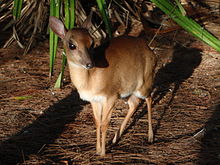| Suni | |
|---|---|

| |
| Male | |

| |
| Female | |
| Scientific classification | |
| Domain: | Eukaryota |
| Kingdom: | Animalia |
| Phylum: | Chordata |
| Class: | Mammalia |
| Order: | Artiodactyla |
| Family: | Bovidae |
| Genus: | Nesotragus |
| Species: | N. moschatus
|
| Binomial name | |
| Nesotragus moschatus (Von Dueben, 1846)
| |

| |
| Synonyms | |
| |
The suni (Nesotragus moschatus) is a small antelope of the family Bovidae, and one of the smallest ungulates on earth. It occurs in dense underbrush from central Kenya to KwaZulu-Natal in South Africa. It is also found on the island of Zanzibar off of Tanzania.[2]
Suni are around 30 to 43 centimetres (12 to 17 inches) high at the shoulder and weigh 4.5 to 5.4 kilograms (9 lb 15 oz to 11 lb 14 oz). They are usually reddish brown, darker on their back than their sides and legs. The belly, chin, throat and insides of legs are white. The nostrils are prominent red, and there are black rings around the eyes and above the hooves. Males have horns 8–13 cm (3–5 in) long, that are ridged most of their length and curve backwards close to their heads. Females do not have horns. Suni can make weak barking and whistling sounds.
Suni feed on leaves, fungi, fruits and flowers, and need almost no free water. They are shy, most active at night, and sleep during the day in a shady, sheltered area. They are social but males defend a territory of about three hectares. They scent-mark the boundaries with secretions from their preorbital glands. There may be an individual or communal dung pile on the periphery of the territory. A male usually takes one mate, but other females may share his territory. A single calf is born weighing about two pounds, after a gestation of 183 days.
Felids, raptors, snakes, and other meat-eaters prey on suni. For protection, they are well camouflaged in dry grass and keep very still. When a predator is almost on top of them, they spring out and bound away into the underbrush.
- ^ IUCN SSC Antelope Specialist Group (2016). "Nesotragus moschatus". IUCN Red List of Threatened Species. 2016: e.T14604A50191073. doi:10.2305/IUCN.UK.2016-1.RLTS.T14604A50191073.en. Retrieved 12 November 2021.
- ^ "Observations - iNaturalist". iNaturalist. Retrieved 20 March 2024.
